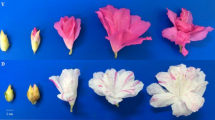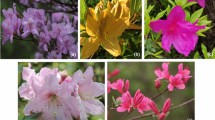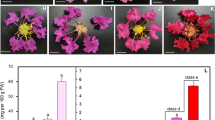Abstract
Yellow-flowering species are unique in the genus Camellia not only for their bright yellow pigments but also the health-improving substances in petals. However, little is known regarding the biosynthesis pathways of pigments and secondary metabolites. Here, we performed comparative genomics studies in two yellow-flowered species of the genus Camellia with distinctive flowering periods. We obtained 112,190 and 89,609 unigenes from Camellia nitidissima and Camellia chuongtsoensis, respectively, and identified 9547 gene family clusters shared with various plant species and 3414 single-copy gene families. Global gene expression analysis revealed six comparisons of differentially expressed gene sets in different developmental stages of floral bud. Through the identification of orthologous pairs, conserved and specific differentially expressed genes (DEGs) between species were compared. Functional enrichment analysis suggested that the gibberellin (GA) biosynthesis pathway might be related to the alteration of flowering responses. Furthermore, the expression patterns of secondary metabolism pathway genes were analyzed between yellow- and red-flowered Camellias. We showed that the key enzymes involved in glycosylation of flavonoids displayed differential expression patterns, indicating that the direct glycosylation of flavonols rather than anthocyanins was pivotal to coloration and health-improving metabolites in the yellow Camellia petals. Finally, the gene family analysis of UDP-glycosyltransferases revealed an expansion of group C members in C. nitidissima. Through comparative genomics analysis, we demonstrate that changes of gene expression and gene family members are critical to the variation of natural traits. This work provides valuable insights into the molecular regulation of trait adaptations of floral pigmentation and flowering timing.







Similar content being viewed by others
References
Anderson JT, Willis JH, Mitchell-Olds T (2011) Evolutionary genetics of plant adaptation. Trends Genet 27:258–266
Ashihara H, Deng W-W, Mullen W, Crozier A (2010) Distribution and biosynthesis of flavan-3-ols in Camellia sinensis seedlings and expression of genes encoding biosynthetic enzymes. Phytochemistry 71:559–566
Barrett SC (2008) Major evolutionary transitions in flowering plant reproduction: an overview
Bluemel M, Dally N, Jung C (2015) Flowering time regulation in crops—what did we learn from Arabidopsis? Curr Opin Biotechnol 32:121–129
Casacuberta JM, Jackson S, Panaud O, Purugganan M, Wendel J (2016) Evolution of plant phenotypes, from genomes to traits. G3-Genes Genom Genet 6:775–778
Chang Hd RS (1998) Flora of China. Science Press
Cooke JEK, Eriksson ME, Junttila O (2012) The dynamic nature of bud dormancy in trees: environmental control and molecular mechanisms. Plant Cell Environ 35:1707–1728
Cui L, Yao S, Dai X, Yin Q, Liu Y, Jiang X, Wu Y, Qian Y, Pang Y, Gao L (2016) Identification of UDP-glycosyltransferases involved in the biosynthesis of astringent taste compounds in tea (Camellia sinensis). J Exp Bot 67:2285–2297
Dong B, Wu B, Hong WH, Li XP, Li Z, Xue L, Huang YF (2017) Transcriptome analysis of the tea oil camellia (Camellia oleifera) reveals candidate drought stress genes. PLoS One 12:e0181835
Fan ZQ, Li JY, Li XL, Wu B, Wang JY, Liu ZC, Yin HF (2015) Genome-wide transcriptome profiling provides insights into floral bud development of summer-flowering Camellia azalea. Sci Rep 5
Freeman S, West J, James C, Lea V, Mayes S (2004) Isolation and characterization of highly polymorphic microsatellites in tea (Camellia sinensis). Mol Ecol Resour 4:324–326
Gordon A, Hannon G (2010) Fastx-toolkit. FASTQ/A short-reads pre-processing tools. Unpublished Available online at: http://hannonlab.cshl. edu/fastx_toolkit
Haas BJ, Papanicolaou A, Yassour M, Grabherr M, Blood PD, Bowden J, Couger MB, Eccles D, Li B, Lieber M (2013) De novo transcript sequence reconstruction from RNA-Seq: reference generation and analysis with trinity. Nat Protoc 8:1494–1512
Hall BG (2013) Building phylogenetic trees from molecular data with MEGA. Mol Biol Evol 30:1229–1235
Higdon JV, Frei B (2003) Tea catechins and polyphenols: health effects, metabolism, and antioxidant functions
Hsu C-Y, Adams JP, Kim H, No K, Ma C, Strauss SH, Drnevich J, Vandervelde L, Ellis JD, Rice BM (2011) FLOWERING LOCUS T duplication coordinates reproductive and vegetative growth in perennial poplar. Proc Natl Acad Sci 108:10756–10761
Huang H, Tong Y, Zhang Q-J, Gao L-Z (2013) Genome size variation among and within Camellia species by using flow cytometric analysis. PLoS One 8:e64981
Hwang Y-J, Yoshikawa K, Miyajima I, Okubo H (1992) Flower colors and pigments in hybrids with Camellia chrysantha. Sci Hortic 51:251–259
Komeda Y (2004) Genetic regulation of time to flower in Arabidopsis thaliana. Annu Rev Plant Biol 55:521–535
Li J-B, Hashimoto F, Shimizu K, Sakata Y (2008) Anthocyanins from red flowers of Camellia cultivar ‘Dalicha’. Phytochemistry 69:3166–3171
Li J-B, Hashimoto F, Shimizu K, Sakata Y (2013) Chemical taxonomy of red-flowered wild Camellia species based on floral anthocyanins. Phytochemistry 85:99–106
Li CF, Zhu Y, Yu Y, Zhao QY, Wang SJ, Wang XC, Yao MZ, Luo D, Li X, Chen L, Yang YJ (2015) Global transcriptome and gene regulation network for secondary metabolite biosynthesis of tea plant (Camellia sinensis). BMC Genomics 16:560
Li X, Li J, Fan Z, Liu Z, Tanaka T, Yin H (2017) Global gene expression defines faded whorl specification of double flower domestication in Camellia. Sci Rep 7:3197
Livak KJ, Schmittgen TD (2001) Analysis of relative gene expression data using real-time quantitative PCR and the 2(T)(−Delta Delta C) method. Methods 25:402–408
Ming T, Zhang W (1993) On taxonomic problems of sect. Archecamellia Sealy and sect. Chrysantha Chang in the genus Camellia. Acta Bot Yunnanica 15:1–15
Ohgami S, Ono E, Toyonaga H, Watanabe N, Ohnishi T (2014) Identification and characterization of Camellia sinensis glucosyltransferase, UGT73A17: a possible role in flavonol glucosylation. Plant Biotechnol 31:573–578
Ohgami S, Ono E, Horikawa M, Murata J, Totsuka K, Toyonaga H, Ohba Y, Dohra H, Asai T, Matsui K (2015) Volatile glycosylation in tea plants: sequential glycosylations for the biosynthesis of aroma β-primeverosides are catalyzed by two Camellia sinensis glycosyltransferases. Plant Physiol 168:464–477
Olszewski N, Sun TP, Gubler F (2002) Gibberellin signaling: biosynthesis, catabolism, and response pathways. Plant Cell 14(suppl 1):S61–S80
Orel G, Curry AS (2015) In pursuit of hidden camellias: 32 new'Camellia'species from Vietnam and China. Orel & Curry
Orel G, Wilson PG, Curry AS, Truong LH (2014) Four new species and two new sections of Camellia (Theaceae) from Vietnam. Novon 23:307–318
Park J-S, Kim J-B, Hahn B-S, Kim K-H, Ha S-H, Kim J-B, Kim Y-H (2004) EST analysis of genes involved in secondary metabolism in Camellia sinensis (tea), using suppression subtractive hybridization. Plant Sci 166:953–961
Punyasiri P, Abeysinghe I, Kumar V, Treutter D, Duy D, Gosch C, Martens S, Forkmann G, Fischer T (2004) Flavonoid biosynthesis in the tea plant Camellia sinensis: properties of enzymes of the prominent epicatechin and catechin pathways. Arch Biochem Biophys 431:22–30
Ross-Ibarra J, Morrell PL, Gaut BS (2007) Plant domestication, a unique opportunity to identify the genetic basis of adaptation. Proc Natl Acad Sci U S A 104(Suppl 1):8641–8648
Sealy JR (1958) A revision of the genus Camellia. A Revision of the Genus Camellia
Shi CY, Yang H, Wei CL, Yu O, Zhang ZZ, Jiang CJ, Sun J, Li YY, Chen Q, Xia T, Wan XC (2011) Deep sequencing of the Camellia sinensis transcriptome revealed candidate genes for major metabolic pathways of tea-specific compounds. BMC Genomics 12
Singh K, Rani A, Kumar S, Sood P, Mahajan M, Yadav SK, Singh B, Ahuja PS (2008) An early gene of the flavonoid pathway, flavanone 3-hydroxylase, exhibits a positive relationship with the concentration of catechins in tea (Camellia sinensis). Tree Physiol 28:1349–1356
Sisa M, Bonnet SL, Ferreira D, Van Der Westhuizen JH (2010) Photochemistry of flavonoids. Molecules 15:5196–5245
Song L, Wang X, Zheng X, Huang D (2011) Polyphenolic antioxidant profiles of yellow camellia. Food Chem 129:351–357
Sun Y, Fan Z, Li X, Liu Z, Li J, Yin H (2014) Distinct double flower varieties in Camellia japonica exhibit both expansion and contraction of C-class gene expression. BMC Plant Biol 14:288
Tang S, Bin X, Wang L, Zhong Y (2006) Genetic diversity and population structure of yellow camellia (Camellia nitidissima) in China as revealed by RAPD and AFLP markers. Biochem Genet 44:444–456
Taniguchi F, Fukuoka H, Tanaka J (2012) Expressed sequence tags from organ-specific cDNA libraries of tea (Camellia sinensis) and polymorphisms and transferability of EST-SSRs across Camellia species. Breed Sci 62:186–195
Tanikawa N, Kashiwabara T, Hokura A, Abe T, Shibata M, Nakayama M (2008) A peculiar yellow flower coloration of camellia using aluminum-flavonoid interaction. J Jpn Soc Hortic Sci 77(4):402–407
Thirugnanasambantham K, Prabu G, Palanisamy S, Chandrabose SRS, Mandal AKA (2013) Analysis of dormant bud (Banjhi) specific transcriptome of tea (Camellia sinensis (L.) O. Kuntze) from cDNA library revealed dormancy-related genes. Appl Biochem Biotechnol 169:1405–1417
Tuyama T (1968) Camellias of Japan. Takeda Science Foundation
Wang XC, Zhao QY, Ma CL, Zhang ZH, Cao HL, Kong YM, Yue C, Hao XY, Chen L, Ma JQ, Jin JQ, Li X, Yang YJ (2013) Global transcriptome profiles of Camellia sinensis during cold acclimation. BMC Genomics 14:415
Wang ZW, Jiang C, Wen Q, Wang N, Tao YY, Xu LA (2014) Deep sequencing of the Camellia chekiangoleosa transcriptome revealed candidate genes for anthocyanin biosynthesis. Gene 538:1–7
Wang Y, Coleman-Derr D, Chen G, Gu YQ (2015) OrthoVenn: a web server for genome wide comparison and annotation of orthologous clusters across multiple species. Nucleic Acids Res 43:W78–W84
Xia EH, Zhang HB, Sheng J, Li K, Zhang QJ, Kim C, Zhang Y, Liu Y, Zhu T, Li W, Huang H, Tong Y, Nan H, Shi C, Shi C, Jiang JJ, Mao SY, Jiao JY, Zhang D, Zhao Y, Zhao YJ, Zhang LP, Liu YL, Liu BY, Yu Y, Shao SF, Ni DJ, Eichler EE, Gao LZ (2017) The tea tree genome provides insights into tea flavor and independent evolution of caffeine biosynthesis. Mol Plant 10:866–877
Yin H, Fan Z, Li X, Wang J, Liu W, Wu B, Ying Z, Liu L, Liu Z, Li J (2016) Phylogenetic tree-informed microRNAome analysis uncovers conserved and lineage-specific miRNAs in Camellia during floral organ development. J Exp Bot 67:2641–2653
Zhang HB, Xia EH, Huang H, Jiang JJ, Liu BY, Gao LZ (2015) De novo transcriptome assembly of the wild relative of tea tree (Camellia taliensis) and comparative analysis with tea transcriptome identified putative genes associated with tea quality and stress response. BMC Genomics 16
Zhao L-P, Liu Z, Chen L, Yao M-Z, Wang X-C (2008) Generation and characterization of 24 novel EST derived microsatellites from tea plant (Camellia sinensis) and cross-species amplification in its closely related species and varieties. Conserv Genet 9:1327–1331
Zhou X-W, Fan Z-Q, Chen Y, Zhu Y-L, Li J-Y, Yin H-F (2013) Functional analyses of a flavonol synthase–like gene from Camellia nitidissima reveal its roles in flavonoid metabolism during floral pigmentation. J Biosci 38:593–604
Acknowledgments
We are grateful to the anonymous reviewer for critical comments and suggestions on the earlier version of manuscript.
Authors’ contributions
XL, WY, TL, JW, and JTW prepared samples and RNA sequencing. HG, LX, NY, and HY carried out data processing, assembly, and gene family analysis. JW, ZF, and BW performed gene expression analysis. XL, JL, and HY interpreted the data and supervised the project. HY and XL drafted the manuscript and all authors participated in revision. All authors read and approved the final manuscript.
Funding
This work was supported by Nonprofit Research Projects (CAFYBB2017ZX001-7, CAFYBB2016SZ001) of Chinese Academy of Forestry, and National Science Foundation of China (NSFC) Grant 31470697. We also acknowledge the supports from the Zhejiang province science and technology plan (2013C32075) and International Sci. & Tech. Cooperation Program of China (2016YFE0126100). We thank Prof. Tongming Yin from Nanjing Forestry University (Nanjing, China) for the help of YellowCamelliaDB web portal.
Author information
Authors and Affiliations
Corresponding author
Ethics declarations
Competing interests
The authors declare that they have no competing interests.
Electronic supplementary material
ESM 1
(PDF 429 kb)
Supplementary table 1
(DOCX 17 kb)
Supplementary table 2
(DOCX 20 kb)
Supplementary table 3
(DOCX 22 kb)
Supplementary table 4
(DOCX 18 kb)
Rights and permissions
About this article
Cite this article
Li, X., Fan, Z., Guo, H. et al. Comparative genomics analysis reveals gene family expansion and changes of expression patterns associated with natural adaptations of flowering time and secondary metabolism in yellow Camellia. Funct Integr Genomics 18, 659–671 (2018). https://doi.org/10.1007/s10142-018-0617-9
Received:
Revised:
Accepted:
Published:
Issue Date:
DOI: https://doi.org/10.1007/s10142-018-0617-9




